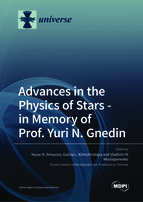Advances in the Physics of Stars - in Memory of Prof. Yuri N. Gnedin
A special issue of Universe (ISSN 2218-1997). This special issue belongs to the section "Galaxies and Clusters".
Deadline for manuscript submissions: closed (31 December 2021) | Viewed by 25251
Special Issue Editors
Interests: astrophysics
2. Peter the Great Saint Petersburg Polytechnic University, 195251 Saint Petersburg, Russia
Interests: astrophysics; atomic physics; condensed matter physics
Special Issues, Collections and Topics in MDPI journals
2. Peter the Great Saint Petersburg Polytechnic University, 195251 Saint Petersburg, Russia
Interests: astrophysics; cosmology; quantum field theory
Special Issues, Collections and Topics in MDPI journals
Special Issue Information
Dear Colleagues,
This Special Issue will collect articles devoted to all aspects of the physics of stars and galaxies, including an investigation of their types, properties, stages of evolution, and distribution in the Universe. It is devoted to the memory of outstanding scientist Prof. Dr. Yuri N. Gnedin who not only organized the Department of Astrophysics at Pulkovo Astronomical Observatory of the Russian Academy of Sciences and led it for several decades, but also initiated a number of prospective research projects in several other astrophysical institutions. The scope of scientific interests and expertise of Prof. Gnedin were extraordinarily wide. He produced pioneering works in the theoretical description of polarized radiation transfer, generation of high-energy radiation in tight binary star systems and galactic nuclei, cyclotron lines in spectra of accreting neutron stars, determination of magnetic fields of cosmic sources from polarimetric observations, physics of intermediate-mass and supermassive black holes and magnetic white dwarfs, supernovae, exoplanets and dark satellites of stars, cosmic gamma-ray bursts, dark matter and dark energy. Both observational and theoretical aspects of the above and some other subjects will be covered in this Special Issue, which will contain research as well as review articles.
Prof. Dr. Nazar R. Ikhsanov
Prof. Dr. Galina L. Klimchitskaya
Prof. Dr. Vladimir M. Mostepanenko
Guest Editors
Manuscript Submission Information
Manuscripts should be submitted online at www.mdpi.com by registering and logging in to this website. Once you are registered, click here to go to the submission form. Manuscripts can be submitted until the deadline. All submissions that pass pre-check are peer-reviewed. Accepted papers will be published continuously in the journal (as soon as accepted) and will be listed together on the special issue website. Research articles, review articles as well as short communications are invited. For planned papers, a title and short abstract (about 100 words) can be sent to the Editorial Office for announcement on this website.
Submitted manuscripts should not have been published previously, nor be under consideration for publication elsewhere (except conference proceedings papers). All manuscripts are thoroughly refereed through a single-blind peer-review process. A guide for authors and other relevant information for submission of manuscripts is available on the Instructions for Authors page. Universe is an international peer-reviewed open access monthly journal published by MDPI.
Please visit the Instructions for Authors page before submitting a manuscript. Submitted papers should be well formatted and use good English. Authors may use MDPI's English editing service prior to publication or during author revisions.
Keywords
- stars
- black holes
- neutron stars
- white dwarfs
- gamma-ray bursts
- galactic nuclei
- supernovae
- radiation transfer
- exoplanets
- dark matter
- dark energy








